The Baby Bottle Holder Market is estimated to be valued at USD 3.5 billion in 2025 and is projected to reach USD 5.4 billion by 2035, registering a compound annual growth rate (CAGR) of 4.4% over the forecast period.
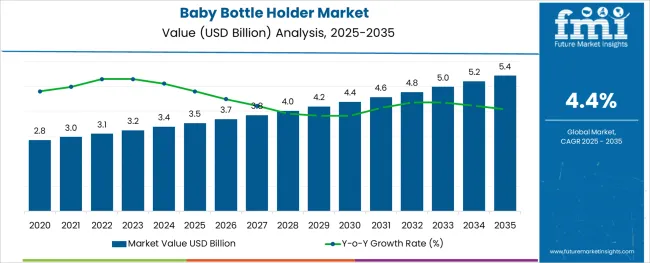
The baby bottle holder market is expanding steadily, driven by increased parental focus on infant convenience and safety during feeding times. Industry insights suggest that growing awareness about ergonomic and hygienic feeding accessories is prompting higher adoption rates. The market benefits from rising birth rates in key regions and evolving lifestyles where multitasking parents seek hands-free feeding solutions.
Product innovation, particularly in premium segments, has introduced holders made from safe, durable materials that offer ease of use and enhanced grip. Retail channel diversification, including direct sales and online platforms, has improved product accessibility.
Growing household penetration of baby care products and targeted marketing campaigns have further encouraged market expansion. The market outlook is optimistic with anticipated growth supported by advancements in holder design and expanding end-user base. Premium pricing and household usage dominate segmental growth while direct sales channels continue to gain traction.
The market is segmented by Price Range, End User, and Sales Channel and region. By Price Range, the market is divided into Premium, Economical, and Low. In terms of End User, the market is classified into Household and Commercial. Based on Sales Channel, the market is segmented into Direct and Indirect. Regionally, the market is classified into North America, Latin America, Western Europe, Eastern Europe, Balkan & Baltic Countries, Russia & Belarus, Central Asia, East Asia, South Asia & Pacific, and the Middle East & Africa.
The Premium segment is expected to contribute 54.3% of the baby bottle holder market revenue in 2025, reflecting consumer preference for high-quality and feature-rich products. This segment’s growth has been supported by parents willing to invest in ergonomic designs that ensure better safety and convenience.
Premium holders often incorporate superior materials, adjustable features, and aesthetics that appeal to modern consumers. Brand trust and product durability play significant roles in driving demand within this segment.
As awareness about infant health and feeding safety grows, premium products have become increasingly popular in both developed and emerging markets. The segment’s success is further buoyed by the ability to meet diverse consumer needs through innovative design.
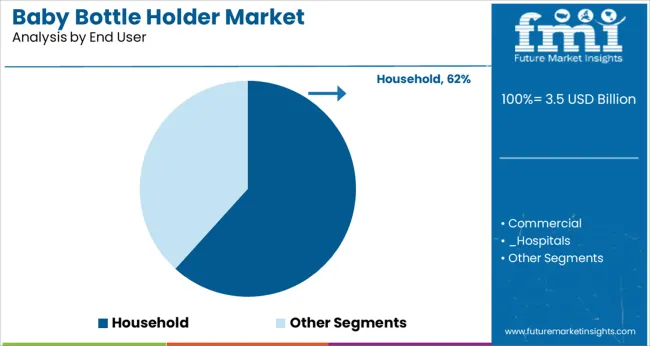
The Household segment is projected to hold 61.7% of the baby bottle holder market revenue in 2025, maintaining dominance as the primary end user. This growth is attributed to widespread adoption of baby bottle holders by parents and caregivers for daily use.
Convenience and functionality in home settings have driven the popularity of these products. The segment benefits from rising awareness about infant feeding hygiene and ergonomic solutions that facilitate multitasking during feeding.
Increasing disposable incomes and changing family dynamics have further encouraged household purchases. Additionally, product availability in multiple retail channels has improved access for this user base. The Household segment is expected to continue its market leadership as parenting trends emphasize practicality and safety.
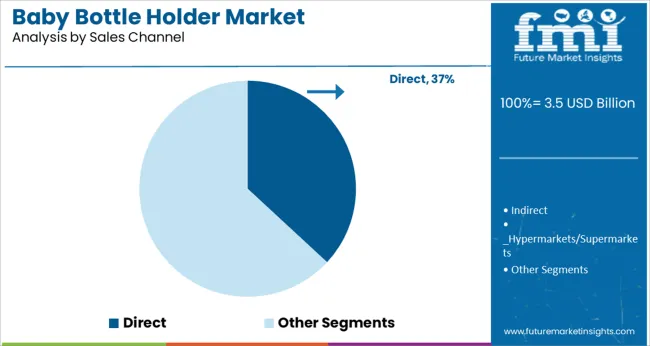
The Direct sales channel segment is expected to contribute 36.9% of the market revenue in 2025, emerging as a significant distribution avenue. Growth in this channel has been driven by manufacturers and brands engaging directly with consumers through online platforms, brand websites, and social media campaigns.
Direct sales offer consumers personalized service, product customization options, and competitive pricing by eliminating intermediaries. This channel also facilitates quick feedback loops and customer engagement, allowing brands to respond swiftly to consumer preferences.
With the rise of e-commerce and digital marketing, direct sales have gained momentum, especially among younger, tech-savvy parents. The Direct segment is anticipated to maintain growth as digital commerce becomes increasingly integral to consumer purchasing behaviors.
The growing number of working women is one of the primary growth drivers for the sales of baby bottle holder since women are too preoccupied with their job schedules to devote enough time to their children.
With time, demand for baby bottle holder products is likely to grow. Companies are also releasing more fashionable options. These styles range from the charming ones that come to mind when thinking of newborns to more sophisticated kinds with contemporary patterns.
The expansion of infant care goods is due to the development of innovative and convenient products for babies all around the world.
Companies are now designing items that are not only safe but also durable, user-friendly, and adapted to the needs of busy parents. Hence sales of baby bottle holder are increased due to built-in bottle holders for the parents, built-in wipes containers, and customizable storage.
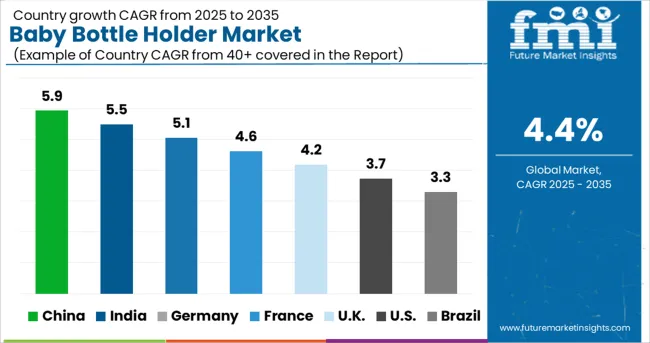
During the projected period, the sales of baby bottle holder market are likely to develop at a modest rate across all geographies. The demand for baby bottle holders is expected to increase considerably due to the rising popularity of infant care goods throughout the world.
Due to the profitable expansion in the infant care product business, rising nations are likely to produce substantial demand for baby bottle holders. The infant bottle holder market is predicted to expand at a relatively high pace due to the increasing population and acceptance of new goods among youth in South Asia and East Asia as a whole.
The emerging sales of baby bottle holder in the market of China and India are likely to boost the growth of the demand for baby bottle holder. North America is a rising market, owing to high per capita income and high consumer spending increasing the sales of baby bottle holder, all of which are expected to enhance the overall sales of baby bottle holder.
Furthermore, the Middle East and Africa are expected to develop steadily in the worldwide baby bottle holder market, owing to an increase in the availability of prominent brands as well as rising per capita expenditure.
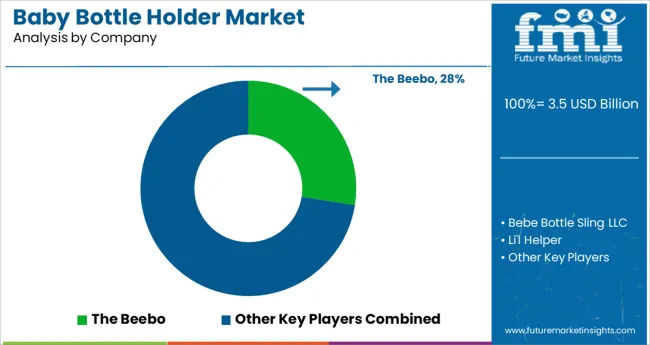
The report consists of key players, contributing to the baby bottle holder market share. It also consists of organic and inorganic growth strategies adopted by market players to improve their market positions. This exclusive report analyzes the competitive landscape and baby bottle holder market share acquired by players to strengthen their market position.
The Beebo, Bebe Bottle Sling LLC, and Li'l Helper are some of the leading participants in the baby bottle holder market.
Recent developments of the Baby Bottle Holder Market:
| Report Attribute | Details |
|---|---|
| Growth rate | CAGR of 4.4% from 2025 to 2035 |
| Base year for estimation | 2024 |
| Historical data | 2020 to 2024 |
| Forecast period | 2025 to 2035 |
| Quantitative units | Revenue in billion, volume in kilotons and CAGR from 2025 to 2035 |
| Report coverage | Revenue forecast, volume forecast, company ranking, competitive landscape, growth factors and trends, Pricing Analysis |
| Segments covered | Price range, end user, sales channel, region |
| Regional scope | North America; Western Europe; Eastern Europe; Middle East; Africa; ASEAN; South Asia; Rest of Asia; Australia and New Zealand |
| Country scope | USA, Canada, Mexico, Germany, UK, France, Italy, Spain, Russia, Belgium, Poland, Czech Republic, China, India, Japan, Australia, Brazil, Argentina, Colombia, Saudi Arabia, UAE, Iran, South Africa |
| Key companies profiled | The Beebo; Bebe Bottle Sling LLC; Li'l Helper |
| Customization scope | Free report customization (equivalent to up to 8 analysts working days) with purchase. Addition or alteration to country, regional & segment scope. |
| Pricing and purchase options | Avail of customized purchase options to meet your exact research needs. |
The global baby bottle holder market is estimated to be valued at USD 3.5 billion in 2025.
It is projected to reach USD 5.4 billion by 2035.
The market is expected to grow at a 4.4% CAGR between 2025 and 2035.
The key product types are premium, economical and low.
household segment is expected to dominate with a 61.7% industry share in 2025.






Our Research Products

The "Full Research Suite" delivers actionable market intel, deep dives on markets or technologies, so clients act faster, cut risk, and unlock growth.

The Leaderboard benchmarks and ranks top vendors, classifying them as Established Leaders, Leading Challengers, or Disruptors & Challengers.

Locates where complements amplify value and substitutes erode it, forecasting net impact by horizon

We deliver granular, decision-grade intel: market sizing, 5-year forecasts, pricing, adoption, usage, revenue, and operational KPIs—plus competitor tracking, regulation, and value chains—across 60 countries broadly.

Spot the shifts before they hit your P&L. We track inflection points, adoption curves, pricing moves, and ecosystem plays to show where demand is heading, why it is changing, and what to do next across high-growth markets and disruptive tech

Real-time reads of user behavior. We track shifting priorities, perceptions of today’s and next-gen services, and provider experience, then pace how fast tech moves from trial to adoption, blending buyer, consumer, and channel inputs with social signals (#WhySwitch, #UX).

Partner with our analyst team to build a custom report designed around your business priorities. From analysing market trends to assessing competitors or crafting bespoke datasets, we tailor insights to your needs.
Supplier Intelligence
Discovery & Profiling
Capacity & Footprint
Performance & Risk
Compliance & Governance
Commercial Readiness
Who Supplies Whom
Scorecards & Shortlists
Playbooks & Docs
Category Intelligence
Definition & Scope
Demand & Use Cases
Cost Drivers
Market Structure
Supply Chain Map
Trade & Policy
Operating Norms
Deliverables
Buyer Intelligence
Account Basics
Spend & Scope
Procurement Model
Vendor Requirements
Terms & Policies
Entry Strategy
Pain Points & Triggers
Outputs
Pricing Analysis
Benchmarks
Trends
Should-Cost
Indexation
Landed Cost
Commercial Terms
Deliverables
Brand Analysis
Positioning & Value Prop
Share & Presence
Customer Evidence
Go-to-Market
Digital & Reputation
Compliance & Trust
KPIs & Gaps
Outputs
Full Research Suite comprises of:
Market outlook & trends analysis
Interviews & case studies
Strategic recommendations
Vendor profiles & capabilities analysis
5-year forecasts
8 regions and 60+ country-level data splits
Market segment data splits
12 months of continuous data updates
DELIVERED AS:
PDF EXCEL ONLINE
Baby Changing Station Market Size and Share Forecast Outlook 2025 to 2035
Baby Car Safety Seat Market Forecast and Outlook 2025 to 2035
Baby Bath and Shower Products Market Size and Share Forecast Outlook 2025 to 2035
Baby Doll Market Size and Share Forecast Outlook 2025 to 2035
Baby & Toddler Carriers & Accessories Market Size and Share Forecast Outlook 2025 to 2035
Baby Shoes Market Size and Share Forecast Outlook 2025 to 2035
Baby Oral Care Market Size and Share Forecast Outlook 2025 to 2035
Baby Ear Thermometer Market Size and Share Forecast Outlook 2025 to 2035
Baby Food Dispensing Spoon Market Size and Share Forecast Outlook 2025 to 2035
Baby Pacifier Thermometer Market Size and Share Forecast Outlook 2025 to 2035
Baby Crib Sheet Market Size and Share Forecast Outlook 2025 to 2035
Baby Teeth Care Products Market Size and Share Forecast Outlook 2025 to 2035
Baby Food Market Analysis - Size, Share, and Forecast Outlook 2025 to 2035
Baby Diaper Market Growth, Forecast, and Trend Analysis 2025 to 2035
Baby Powder Market - Size, Share, and Forecast 2025 to 2035
Baby Sling Market Size and Share Forecast Outlook 2025 to 2035
Baby Toddler Bar Market Analysis - Size, Share, and Forecast Outlook 2025 to 2035
Baby Snacks Market Analysis - Size, Share, & Forecast Outlook 2025 to 2035
Baby Oil Market Analysis - Size, Share, and Forecast Outlook 2025 to 2035
Baby Food Packaging Market Analysis - Size, Share, and Forecast Outlook 2025 to 2035

Thank you!
You will receive an email from our Business Development Manager. Please be sure to check your SPAM/JUNK folder too.
Chat With
MaRIA